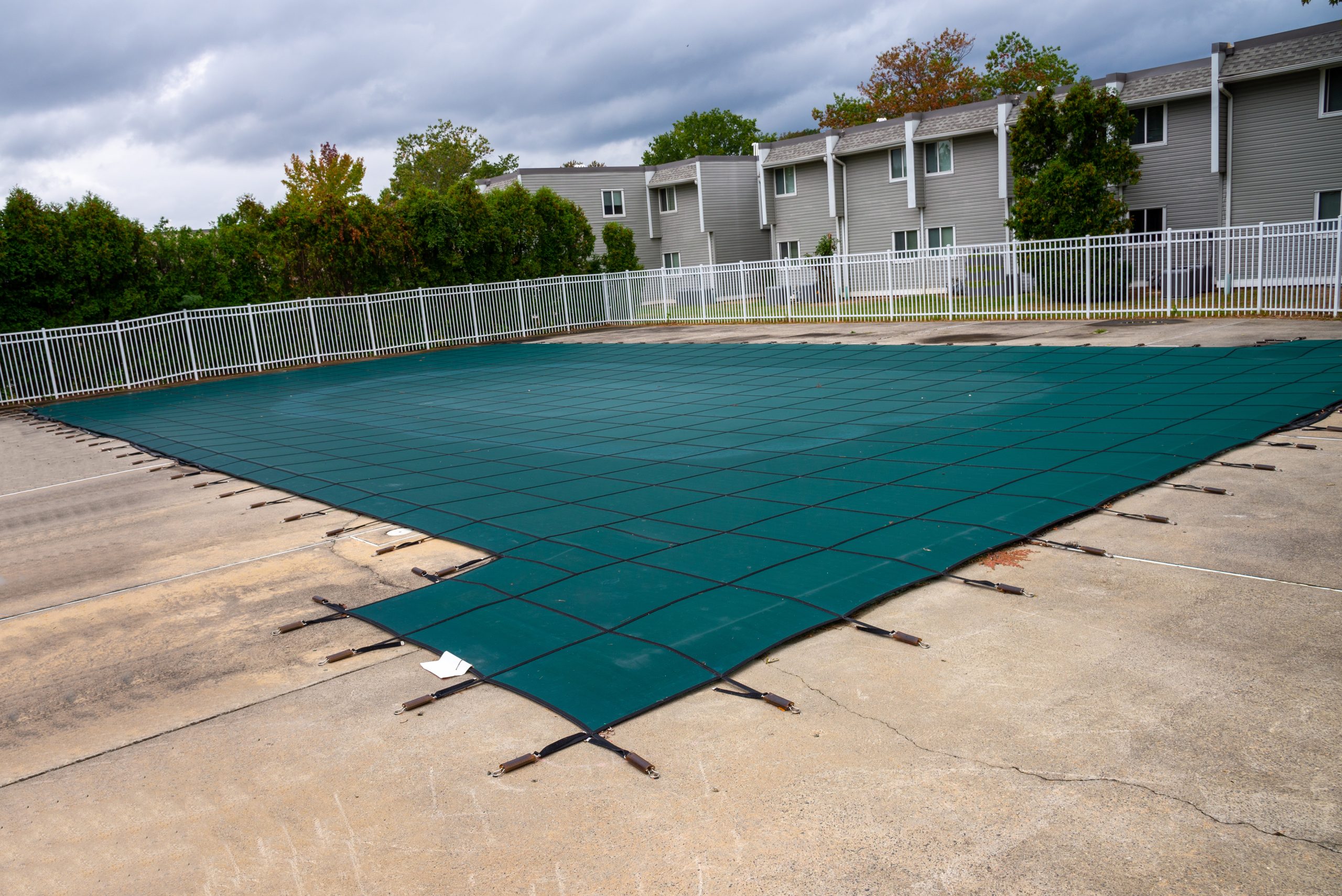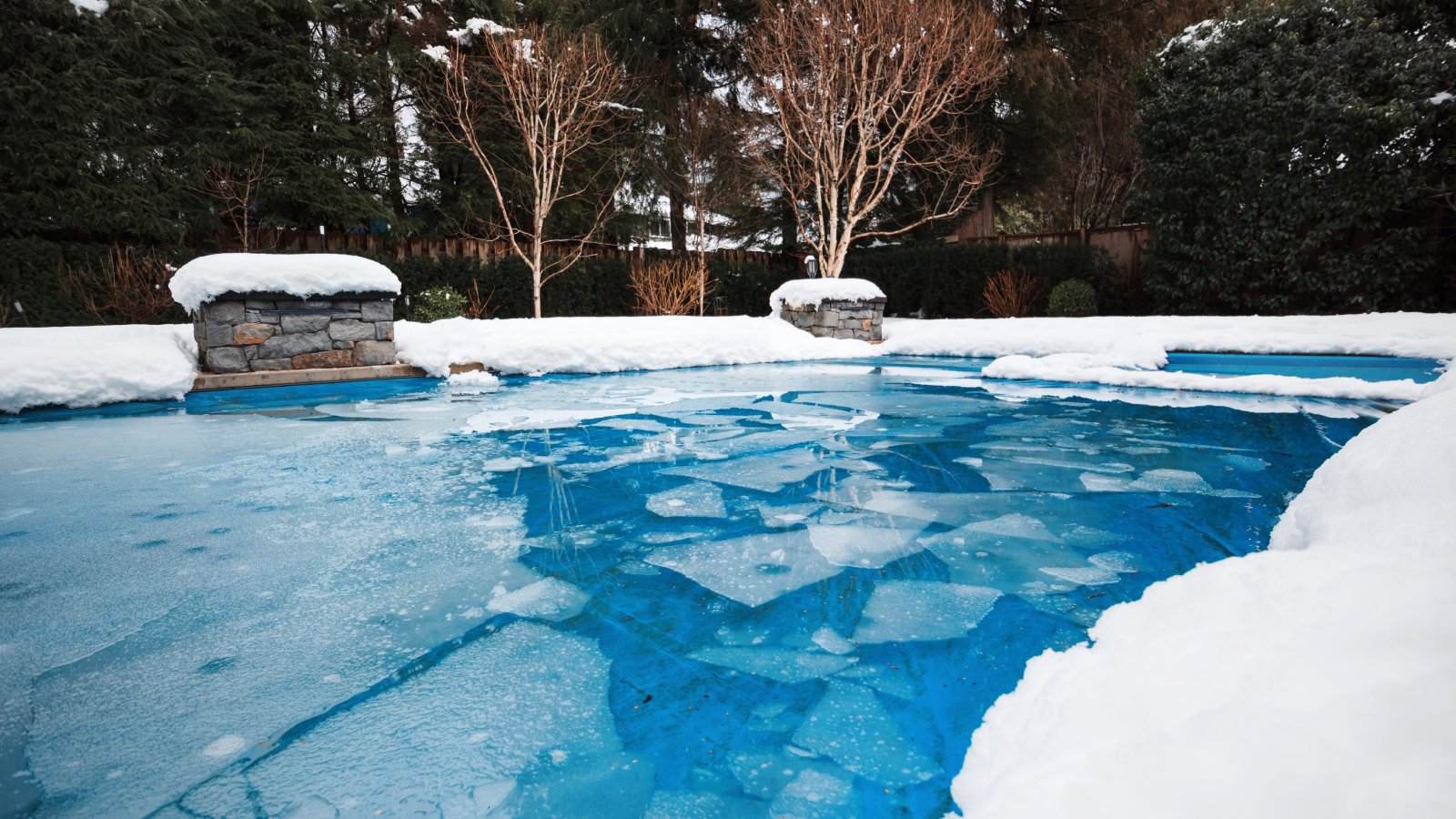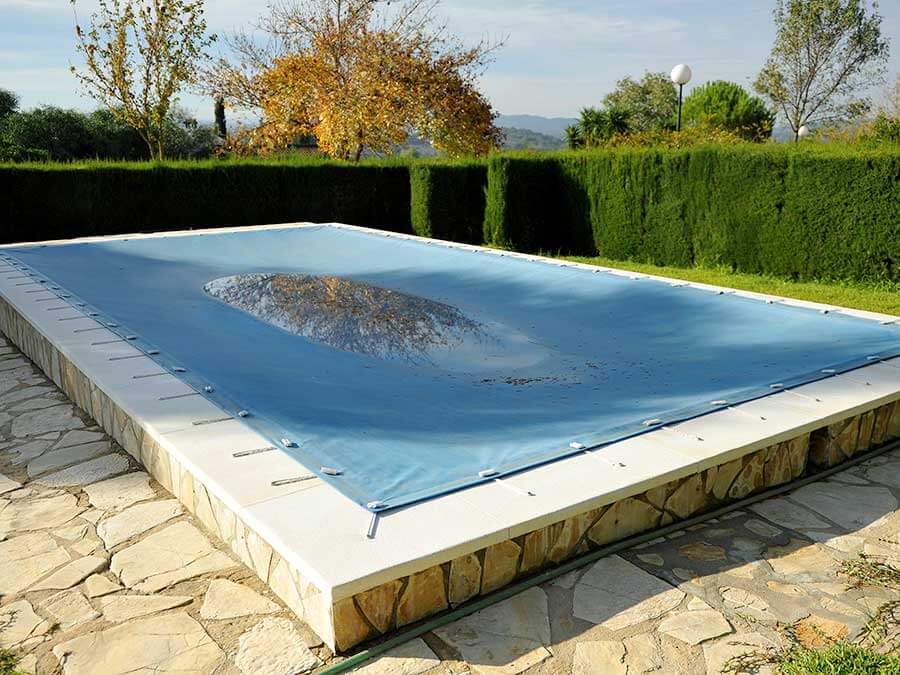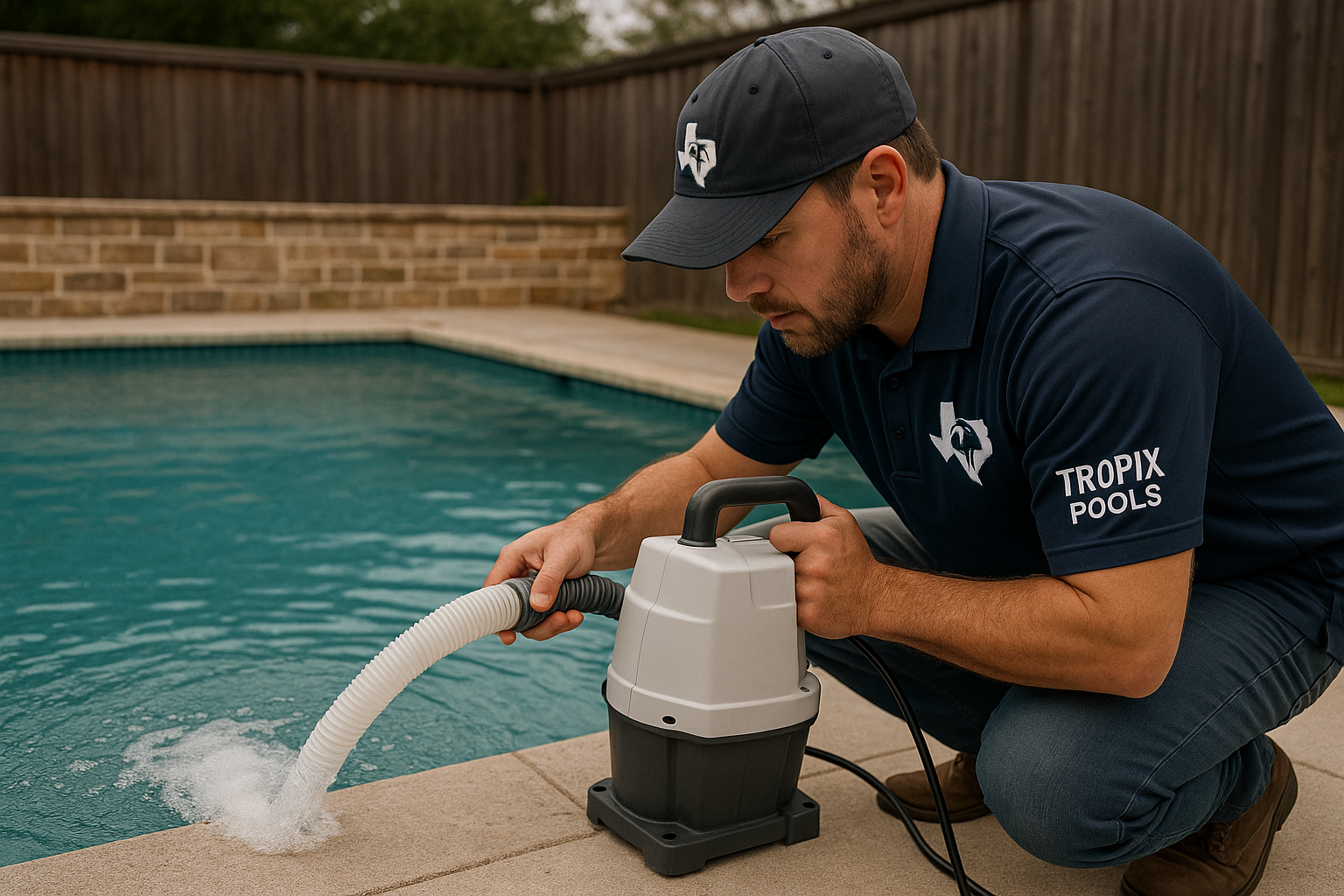As temperatures begin to drop and the vibrant swimming season fades, properly preparing a swimming pool for the colder months becomes a critical annual task.
This process is far more than simply covering the pool; it is a strategic and essential measure designed to safeguard a significant aquatic investment.
Neglecting proper pool winterization can lead to a cascade of costly issues, ranging from severe freeze damage to plumbing and equipment, to the unwelcome sight of stubborn algae blooms and unsightly stains when spring arrives.
Such oversights can transform the joy of pool ownership into a headache of expensive repairs and extensive cleanups.
This comprehensive guide is meticulously crafted to walk pool owners through every essential step of winterization, covering crucial timing, detailed procedures, common pitfalls to meticulously avoid, and providing clear guidance on when considering professional assistance can offer invaluable peace of mind.
The aim is to ensure a pool remains pristine, protected, and effortlessly ready for enjoyment when the next swimming season beckons.
Winterization should be viewed as a critical preventative measure that significantly reduces the likelihood of expensive repairs and inherently prolongs the overall lifespan of the pool and its intricate components.

It represents a strategic investment in the pool’s long-term health and usability.
The various sources consistently highlight “costly damage,” “freeze-damaged tile,” and “broken pool equipment” as direct consequences of inadequate winterization.
This is not merely about general maintenance; it is a deliberate act of preventing severe financial and structural risks.
The implication is that winterization serves as a proactive insurance policy for a pool, actively averting future expenses and structural integrity issues.
The immediate “cost” of winterization (whether for chemicals, time, or professional service) is a small, predictable expense compared to the potentially massive and unexpected “cost” of neglected repairs (e.g., burst pipes, cracked tiles, equipment replacement, extensive algae remediation).
This highlights a profound long-term economic benefit, positioning winterization as an investment in the longevity and value of a pool.
Why is Winterizing Your Pool Essential?

The decision to winterize a pool is rooted in practicality and protection, offering multiple benefits that safeguard the pool and its components throughout the colder months.
Protection Against Freezing Temperatures
The most immediate and severe threat in colder climates is the expansion of freezing water.
When water freezes, it expands with immense force, capable of cracking plumbing lines, damaging filters, pumps, heaters, and even the structural integrity of the pool itself.
Proper winterization involves meticulously draining equipment and clearing lines to eliminate any residual water, thereby preventing this destructive expansion.
This proactive measure is essential to avoid catastrophic and expensive repairs.
Prevention of Algae and Bacteria Growth
During the off-season, stagnant, unmaintained pool water, especially if temperatures are not consistently low enough, provides an ideal breeding ground for algae and various bacteria.
This often leads to the dreaded “green pool” syndrome in spring, necessitating extensive and time-consuming cleanup efforts.
Strategic chemical treatment during winterization is crucial to inhibit such biological growth, ensuring the water remains clear and sanitary.
Reduction in Off-Season Pool Maintenance
While year-round pool maintenance is important, a properly winterized pool drastically reduces the need for routine, labor-intensive tasks such as daily skimming, regular vacuuming, and frequent chemical balancing during the colder months.
This frees up significant time and effort for homeowners, allowing them to defer intensive upkeep until the swimming season returns.
Extension of Equipment Lifespan
Safeguarding essential pool equipment—including pumps, filters, heaters, and chlorinators—from harsh winter elements and freezing conditions is paramount.
Proper winterization prevents premature wear and tear, corrosion, and damage, significantly extending their operational life and delaying the need for costly replacements.
This care helps maintain the efficiency and functionality of the entire pool system.
Enhanced Safety Considerations
In regions experiencing harsh winters, a frozen pool surface can become an unexpected and significant slip and fall hazard.
A securely covered and properly winterized pool eliminates these risks, ensuring the safety of the property throughout the colder months.
This provides peace of mind, especially for families with children or pets.
Easier Spring Opening
A well-winterized pool will be much easier, faster, and less costly to prepare for the next swimming season. By preventing debris accumulation, algae growth, and equipment damage, the effort required for spring opening is drastically reduced, avoiding extensive cleaning and repair work.
When is the Best Time to Winterize Your Pool?

The timing of pool winterization is a critical factor that directly impacts its effectiveness and the prevention of potential issues.
Temperature as Your Guide:
The consensus among pool experts is that the ideal time to winterize a pool is when the water temperature consistently stays below 65°F (18°C).
This temperature threshold is crucial because it significantly slows down the metabolic activity of algae, making chemical treatments more effective and reducing the risk of growth.
This approach emphasizes a dynamic response to environmental conditions rather than a rigid calendar date.
Risks of Closing Too Early
A common mistake pool owners make is closing their pool prematurely while the water is still warm.
If the water temperature remains above 65°F, algae can continue to thrive even under a pool cover, leading to a problematic green pool come spring.
This negates much of the effort of winterization, as the primary goal of preventing algae growth is undermined by incorrect timing.
Risks of Closing Too Late
Conversely, delaying winterization until temperatures plummet to freezing (32°F/0°C) or below introduces immediate and severe risks.
Water left in pipes and equipment can freeze and expand rapidly, causing irreparable damage that is extremely costly to repair. This is why proactive timing, based on consistent temperature monitoring, is paramount.
The decision to winterize should be a precise response to consistent environmental conditions, making informed timing a cornerstone of successful pool protection.
Consider Your Local Climate
It is important to tailor a winterization strategy to the local climate. In milder winter states, such as those in the Sunbelt region (like the DFW Metroplex), the need for intensive procedures like full draining might be reduced.
However, this does not mean neglecting maintenance entirely. In these regions, consistent monitoring of chemical levels and reduced filtration times are still crucial, as algae can persist in warmer water, and unexpected cold snaps can still cause damage.
The 65°F threshold is not an arbitrary number; it directly correlates with the biological activity of algae. Below this temperature, algae growth significantly decelerates, making it easier to control.
Simultaneously, the 32°F freezing point is a critical mechanical threshold, triggering water expansion and potential equipment damage.
This dual consideration reveals that optimal winterization timing is a delicate balance between inhibiting biological threats and preventing mechanical failures.
Step-by-Step Guide: How to Winterize a Pool

Proper pool winterization is a sequential process, with each step building upon the last to ensure comprehensive protection.
1. Deep Cleaning Your Pool:
The winterization process begins with a thorough cleaning. Remove all leaves, silt, and any other floating debris from the pool surface.
Proceed to vacuum the pool meticulously, paying close attention to the floor, and then brush down all the walls to dislodge any clinging dirt or algae.
If the pool has a lot of algae or is especially dirty, it is advisable to bypass the filter and vacuum waste directly out the backwash line. This prevents clogging the filter and reduces the need for repeated cleaning.
A comprehensive cleaning prevents organic matter from decomposing over the winter, which can lead to unsightly staining, heavy debris buildup, and elevated phosphate levels that actively feed algae.
A truly clean pool also significantly simplifies the subsequent steps of balancing water chemistry.
2. Balancing Water Chemistry:
Using a reliable pool testing kit, meticulously test and adjust the pool’s pH, alkalinity, and calcium hardness levels.
Ensure all chemicals are evenly dispersed throughout the pool water.
Unbalanced water chemistry is a leading cause of staining, scaling, and corrosion on pool surfaces and equipment.
Proper balance actively inhibits algae and bacterial growth, protecting the pool’s integrity throughout the dormant season.
Table: Essential Pool Water Chemistry Levels for Winterization
| Parameter | Ideal Range (ppm) | Notes |
|---|---|---|
| pH | 7.2 – 7.6 | Some sources suggest up to 7.8 , but a tighter range is preferred for winter. |
The various sources provide slightly varying but overlapping ranges for chemical levels.
Presenting this information in a consolidated table offers immense value by providing a quick, consolidated reference point for the user, making it easier to compare and apply the information.
It distills complex numerical data into an easily digestible format, enhancing clarity and usability for the homeowner, and highlights the different ranges for different pool types, a crucial detail.
3. Shocking and Chemical Treatment
Add a shock treatment to the pool, strictly following the manufacturer’s directions. Allow the water to circulate for at least 24 hours.
If necessary, re-shock until free chlorine levels reach a stable 1.0 – 3.0 ppm. It is crucial to note: Never add chlorine shock and algaecide to the pool at the same time, as this can cause dangerous reactions.
After shocking, add a high-quality algaecide to specifically target algae spores.
This is also an opportune time to add a stain and scale remover to further protect pool surfaces over the winter.
Ensure all chemicals are evenly dispersed throughout the water. For saltwater pools, test and adjust salinity levels, aiming for around 3,200 ppm.
Shock treatment effectively kills off existing bacteria and helps clarify cloudy water , while algaecide provides long-term protection against algae growth.
4. Lowering Pool Water Level
The water level in the pool needs to be reduced, a particularly critical step if living in an area prone to freezing temperatures.
The exact level depends on the pool cover type: for mesh pool covers, lower the water level approximately 12-18 inches below the skimmer or about a foot below.
For solid pool covers, reduce the water level to 3-6 inches below the tile or half a foot below the skimmer.
Alternatively, lower it at least 2 inches below the lowest return line, or 4-6 inches below the skimmer.
This can be done efficiently using the filter pump (if it has a multiport valve for draining) or a submersible pump with a hose.
A critical point to emphasize is: Do not fully drain the pool. Lowering the water level prevents ice expansion from damaging sensitive components like skimmers, tiles, and the pool’s coping, which are vulnerable to cracking when water freezes around them.
5. Removing Pool Accessories
Carefully remove all removable pool accessories, including skimmer baskets, ladders, diving boards, and slides. Thoroughly hose off or scrub each item clean.
For stubborn grime, a paste of baking soda (2 parts) and water (1 part) works wonders on plastic and metal parts, while a ¾ cup baking soda to ¼ cup water paste can shine chrome fixtures.
Ensure all parts are completely dry before storing them in a shed or another safe, protected place.
Storing accessories prevents damage from harsh cold temperatures, UV exposure, and general wear and tear from the elements, prolonging their lifespan.
6. Draining Pool Pump and Heating Equipment
Crucially, turn off all power to the filter pump and other pool equipment at the circuit breaker.
Locate and remove the drain plugs from the pump (often two), filter (one), chlorinator (one), and heater (often two, if applicable).
Store these drain plugs in a safe, easily accessible place, such as the pump basket, for spring opening.
Use a shop vac or air compressor to blow out any remaining water from the equipment.
For the pump, holding it upside down can help drain excess water. This is also an excellent time to lubricate any valves and O-rings on the equipment to maintain their integrity.
If possible, store the filter and pump indoors.
This step is absolutely critical. Any water remaining in the pump, filter, or heater can freeze, expand, and cause severe, irreparable cracking and damage to these expensive components.
7. Winterizing Pool Plumbing
For inground pools, use a high-powered shop vac or air compressor to meticulously blow out all water from the plumbing lines, starting from the skimmer, through the equipment, and back to the pool.
Once the lines are clear, immediately plug all lines at the pool with specialized expansion plugs to prevent water from re-entering.
As an alternative or additional safeguard, especially in very cold climates, swimming pool antifreeze can be added into the lines.
If a freeze protector is installed, ensure it is operating properly and keep all valves open (skimmers, drains, returns) for optimal water circulation if the pump is running.
This step directly prevents water inside PVC pipes and other plumbing components from freezing and expanding, which will inevitably lead to cracks and costly leaks.
8. Securing Your Pool Cover
The final step is to securely cover the pool. A safety cover, which offers robust protection, or a standard winter cover can be chosen.
Regardless of the type, ensure the cover fits tightly across the entire pool surface and is free of any tears or damage.
It is important to note that inground and above-ground pools require different types of covers designed for their specific structures.
A proper pool cover is essential for protecting the pool from accumulating debris (like leaves and dirt), minimizing water evaporation, and shielding the pool’s surface from prolonged UV exposure damage throughout the winter.
It is an absolute must in any area where a pool needs to be closed for the winter.
The sequence of these eight steps is not arbitrary; it represents a carefully designed chain of actions where each step’s success is often dependent on the proper execution of the preceding one.
For example, thorough cleaning (Step 1) directly facilitates effective chemical balancing (Step 2) by removing organic load.
Balanced chemistry (Step 2) is crucial for the efficacy of shocking and algaecide (Step 3) and prevents corrosion of equipment.
Failure to properly drain equipment (Step 6) or plumbing (Step 7) can render all prior chemical balancing efforts moot if freezing occurs, leading to physical damage regardless of water quality.
This highlights a compounding effect where a single oversight can compromise the entire winterization effort, leading to the very problems one seeks to prevent.
Meticulous attention to detail at each stage is paramount, as skipping or poorly executing one step can have cascading negative effects, undermining the entire effort and leading to significant issues come spring.
What Tools and Chemicals Do You Need for Pool Winterization?

Successfully winterizing a pool requires a specific set of tools and chemicals to ensure every aspect of the pool’s health and integrity is addressed.
Essential Tools for a Smooth Winterization:
- Basic Hand Tools: A screwdriver, wrench, and a ratchet set will be necessary for safely removing pool accessories like ladders and handrails.
- Cleaning Tools: A sturdy wall brush, a leaf net (or leaf rake), and a reliable pool vacuum are fundamental for the initial deep cleaning of the pool.
- Water Level Management: A submersible pump or the pool’s filter pump (if equipped with a drain function) is essential for lowering the water level to the appropriate winterization height.
- Plumbing Protection: An air blower, specifically one designed for high volume and low pressure (like a liner vac), is critically important for blowing out water from plumbing lines, especially for inground pools.
- Sealing Lines: Expansion plugs are needed to seal off return and skimmer lines after they have been blown dry.
- Pool Cover: A seasonal safety cover or a robust winter cover, perfectly fitted to the pool, is the final protective layer.
- Water Testing Kit: An accurate test kit (strips or liquid) is indispensable for monitoring and balancing the pool’s chemistry.
Necessary Chemicals for Winter Protection:
- Chlorine/Sanitizer: To ensure initial sanitation.
- Shock Treatment: A powerful oxidizer to kill bacteria and clear water before closing.
- Algaecide: A specialized chemical to prevent algae growth over the long winter months.
- Stain and Scale Remover: To protect pool surfaces from mineral deposits and staining.
- Non-Toxic Antifreeze: Specifically designed for swimming pool lines, this is a crucial safeguard in areas where freezing is a significant concern.
- pH Increaser/Decreaser: To adjust pH levels within the ideal range.
- Alkalinity Increaser: Such as baking soda, to maintain proper total alkalinity.
- Calcium Hardness Increaser: Like calcium chloride, to prevent scaling or corrosion.
- Winterizing Kit: Many pool supply stores offer pre-packaged winterizing kits that include a combination of these essential chemicals, often tailored for chlorine or non-chlorine pools and varying pool sizes.
Common Mistakes to Avoid When Winterizing Your Pool

Even with a detailed guide, certain common mistakes can undermine the entire winterization effort, leading to significant problems in the spring.
Awareness of these pitfalls is crucial for effective pool protection.
1. Closing the Pool Too Early
As previously discussed, closing when water is consistently above 65°F is a common and costly mistake. This allows algae to thrive under the cover, making spring opening a nightmare of green water and extensive cleaning.
2. Ignoring Water Chemistry Before Closing
Neglecting to test and balance the pool’s pH, alkalinity, and calcium hardness levels before shutdown is a critical oversight.
Unbalanced water chemistry can lead to severe staining, scaling, and corrosion of pool surfaces and expensive equipment (pumps, filters, salt cells) during the long winter months, resulting in significant and preventable repairs.
The damage from unbalanced water is often not immediately visible but accumulates silently, only manifesting as costly issues upon spring opening.
3. Skipping the Final Cleaning
Failing to thoroughly clean the pool—including brushing, vacuuming, and skimming—before covering it allows leaves, dirt, and other organic matter to decompose.
This decomposition increases phosphate levels, which are a primary food source for algae, creating an ideal environment for growth and potentially leading to stubborn stains.
4. Using the Wrong Pool Cover or Not Covering at All
An ill-fitting cover, or the complete absence of a cover, leaves a pool vulnerable.
It fails to protect the pool from accumulating debris, exposes the surface to prolonged UV damage, and allows for excessive water evaporation, all of which complicate spring opening and can lead to damage.
5. Leaving Water in Pool Equipment and Plumbing Lines
This is arguably the most critical and potentially catastrophic mistake in regions experiencing freezing temperatures.
Any water left in pipes, pumps, filters, or heaters will freeze, expand, and inevitably crack or burst these components, leading to extremely expensive replacements and extensive repairs.
This damage is often “hidden” until the pool is reopened, making prevention paramount.
6. Neglecting Year-Round Pool Maintenance (Even in Mild Winters)
Pool owners in warmer climates sometimes mistakenly assume that winter means a complete cessation of maintenance.
However, even mild winters require continued monitoring of chemical levels, skimming, and brushing to prevent algae growth and maintain equipment health.
Additionally, overexerting the filtration system by running it at full capacity is a mistake; reduced run times (a few hours a day) are often sufficient in cooler conditions, saving energy and extending equipment life.
7. Overlooking Offseason Repairs
Delaying necessary repairs for issues like leaks, cracks, or malfunctioning equipment until spring can lead to more extensive and expensive problems.
Addressing these issues during the offseason prevents them from worsening and ensures a pool is ready for use when temperatures rise.
Many of these mistakes cause damage that is not immediately visible but manifests months later, making prevention even more crucial, as the problem is often discovered too late, leading to reactive, expensive fixes rather than proactive, cheaper maintenance.
Should You Drain Your Pool for Winter?

A common question among pool owners is whether to fully drain their pool for the winter. The answer is a resounding no.
The Clear Answer: No, Do Not Drain Completely:
It is a common misconception that pools should be fully drained for winter.
However, expert advice and industry best practices strongly recommend against completely draining a pool, as it can be highly detrimental.
Lowering Water Level is Key:
The correct and recommended procedure involves lowering the pool water level, not emptying it entirely.
This is done to prevent freezing damage to the skimmer and return lines, which are typically located near the top of the pool.
Risks for Above-Ground Pools:
Above-ground pools are specifically designed to be supported by the internal pressure of the water they hold.
Draining them completely removes this crucial structural support, which can cause the pool walls to thrust inwards or even collapse due to external forces. The pool’s design relies on water for stability.
Risks for Inground Pools:
While less prone to outright collapse, fully draining inground pools (especially those with fiberglass or vinyl liners) can lead to significant issues.
These include the liner floating or shifting due to changes in the water table or external ground pressure, and potential structural damage.
Additionally, if a thick sheet of ice forms on the surface, maintaining some water below it is important to prevent liner damage from ice expansion.
For many, draining seems like the logical way to prevent freeze damage. However, the evidence reveals that for pools, water itself is a protective element.
This counter-intuitive aspect needs strong emphasis to prevent severe structural damage.
Considering Professional Pool Winterization?
While a DIY approach to pool winterization is certainly possible, many pool owners opt for professional services due to the complexity of the task and the significant investment a pool represents.
How to Choose a Reputable Professional Pool Service: When selecting a professional for pool winterization or ongoing pool maintenance, several factors should be considered:
- Accreditations and Credentials: Always look for companies that are fully certified and accredited within the industry. This ensures they are properly trained, knowledgeable, and adhere to professional standards.
- Reviews and Testimonials: Thoroughly check online reviews (e.g., Google reviews) and customer testimonials. These provide valuable insights into a company’s reputation, service quality, and customer satisfaction.
- Referrals: Ask friends, family, or neighbors who own pools for their recommendations. Personal referrals often lead to trusted service providers.
- Discuss Services Offered: Before committing, have a detailed discussion about the specific services the company offers. Ensure their winterization packages and ongoing pool maintenance offerings align with specific needs.
- Experience: Opt for companies with a proven track record and several years of experience in the pool service industry. Experience often translates to greater reliability and expertise.
Conclusion
Proper pool winterization is a vital annual ritual for protecting a significant aquatic investment, preventing costly damage, and ensuring a smooth, hassle-free opening in the spring.
While a DIY approach is certainly possible with careful adherence to the detailed steps outlined, understanding the nuances, the interconnectedness of tasks, and the potential pitfalls is paramount.
The analysis indicates that the initial effort and expense associated with proper winterization are minimal when compared to the potential cumulative financial burden and operational headaches that arise from neglecting it.
It embodies a clear “pay now or pay much more later” principle in pool ownership.
The decision to winterize should be driven by consistent water temperature rather than a fixed calendar date, as this dynamic approach effectively mitigates both biological (algae proliferation) and mechanical (freezing damage) risks.
Furthermore, it is critical to understand that fully draining a pool is generally detrimental, as the water itself contributes to the pool’s structural integrity.
Instead, lowering the water level and meticulously draining all equipment and plumbing lines are the correct procedures to prevent freeze damage.
For complex procedures or for those seeking expert assurance, the value and peace of mind offered by professional pool maintenance services are significant.
These experts possess the specialized knowledge and tools to execute winterization correctly, minimizing the risk of costly errors and ensuring the pool is impeccably prepared for its dormant period.
For residents in the DFW metroplex, contacting Tropix Pools for their expert swimming pool builders and winterization services can provide the comprehensive care needed to protect their aquatic oasis through the colder months.


